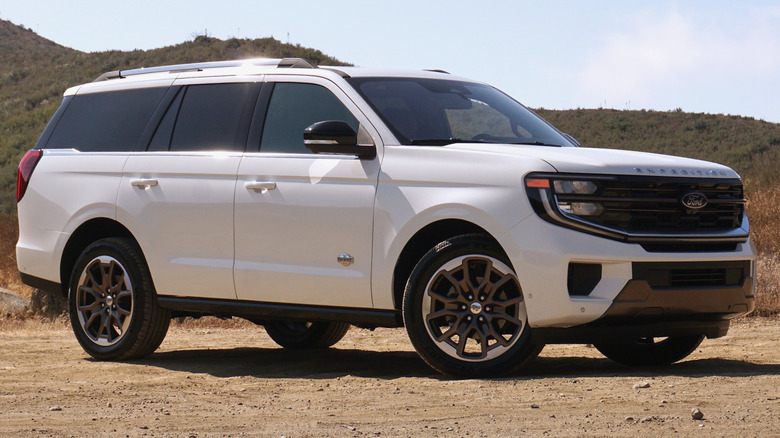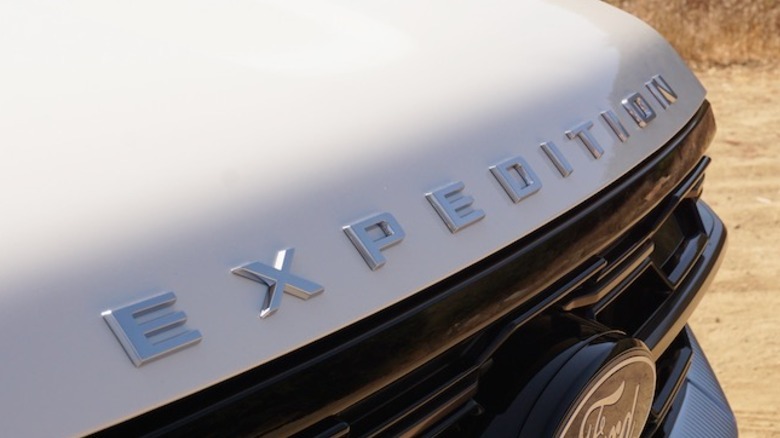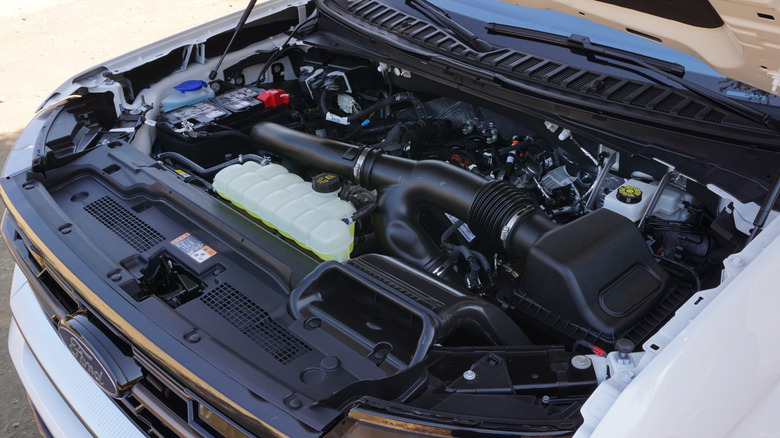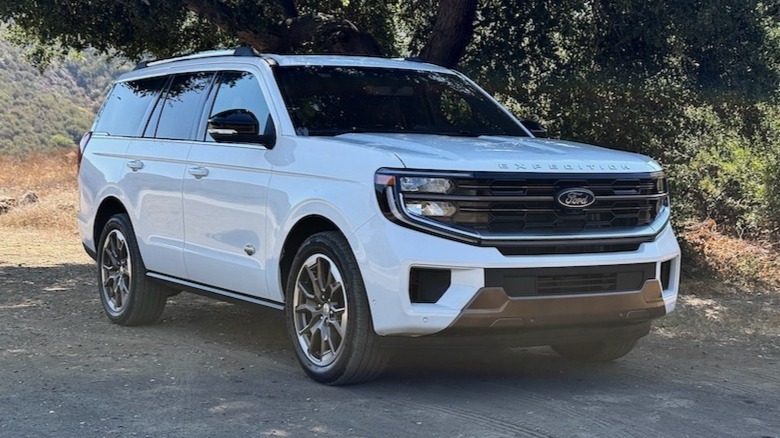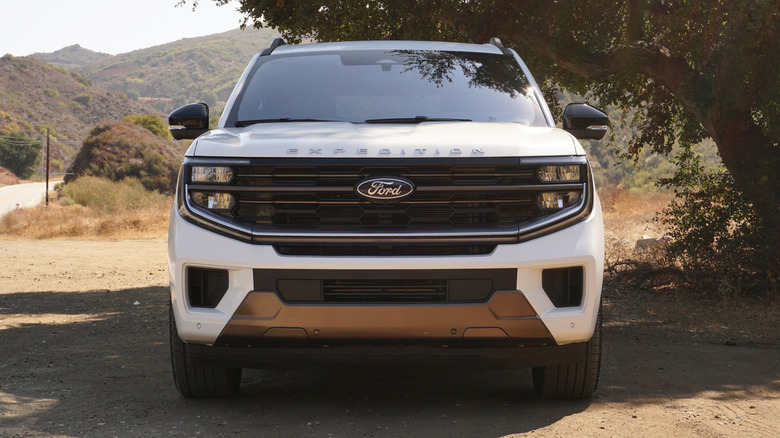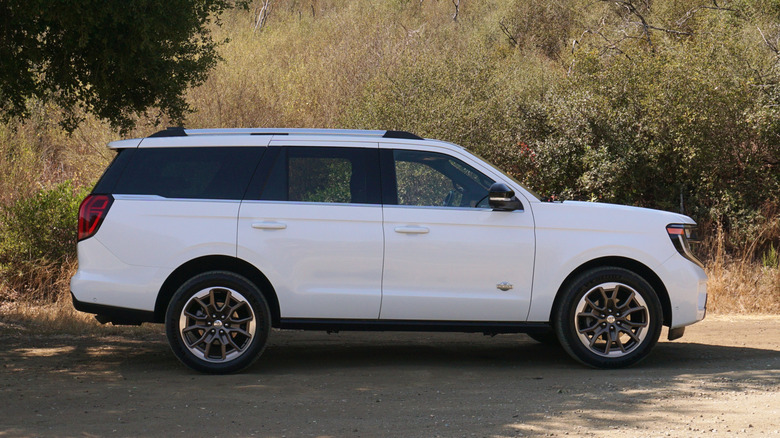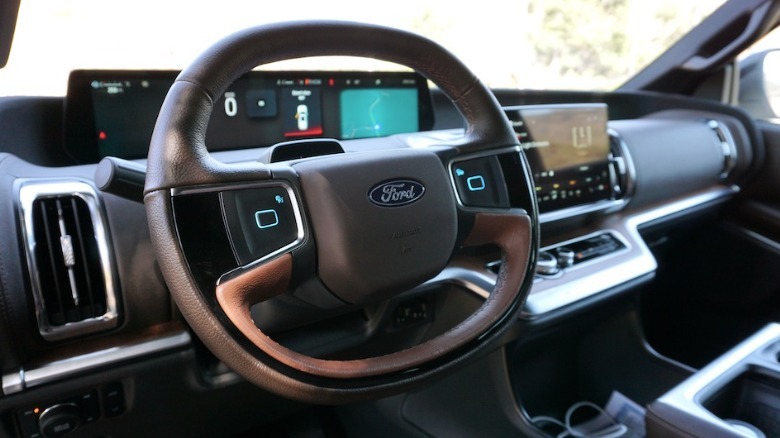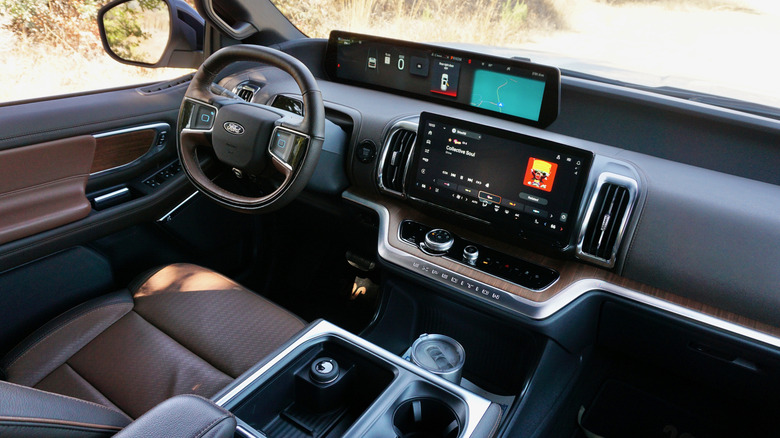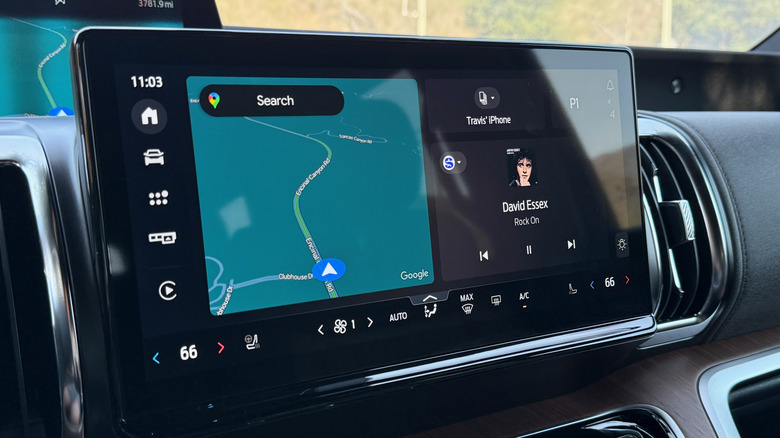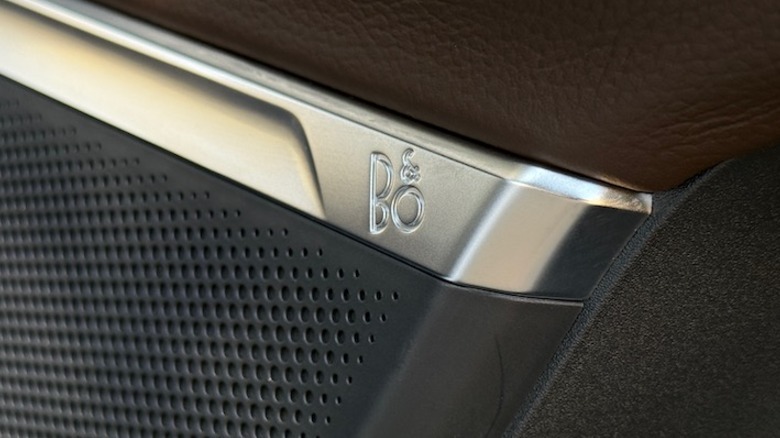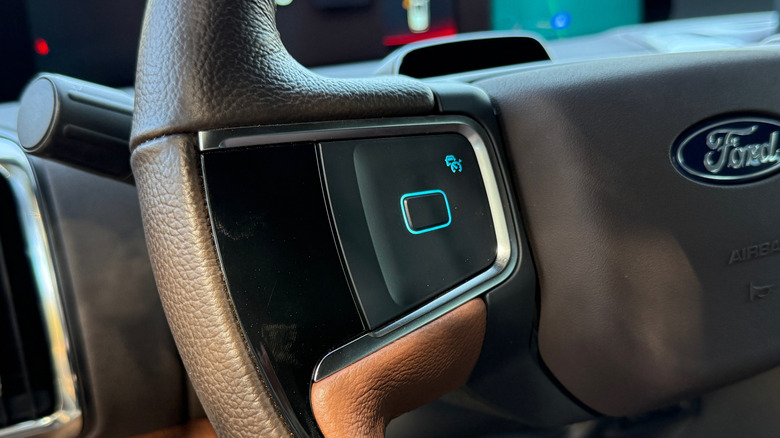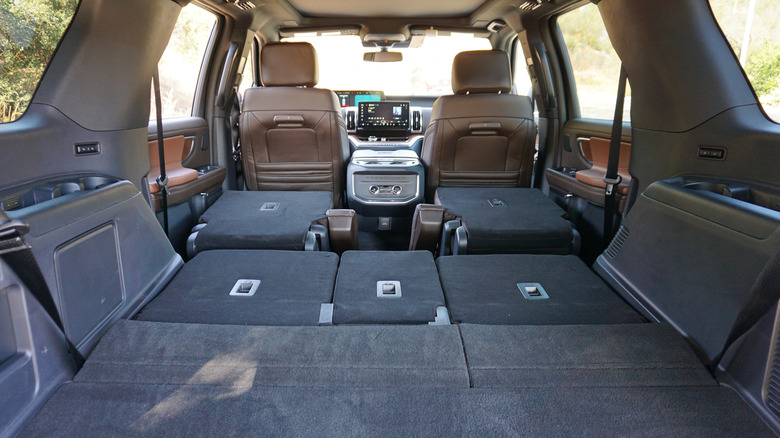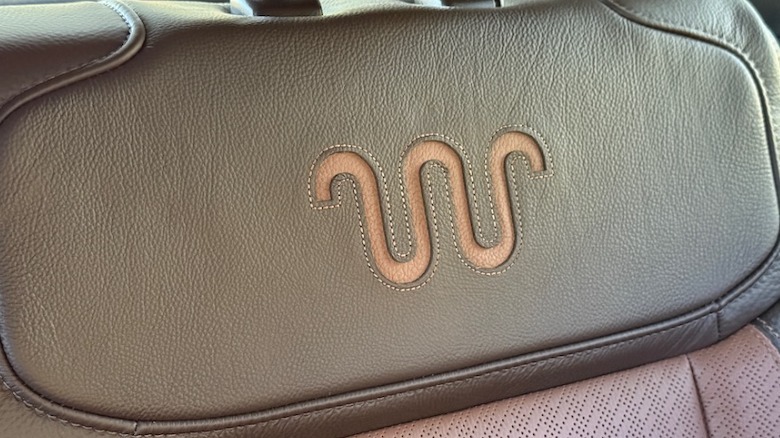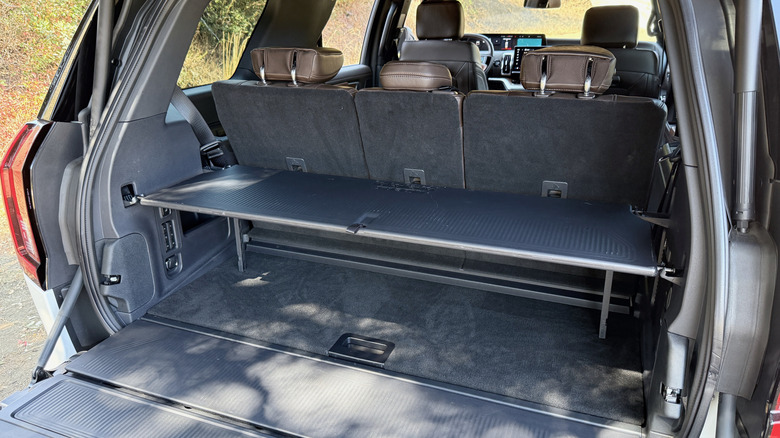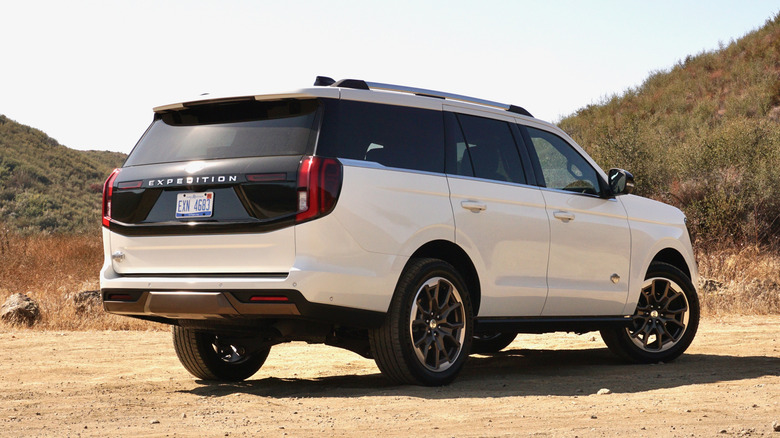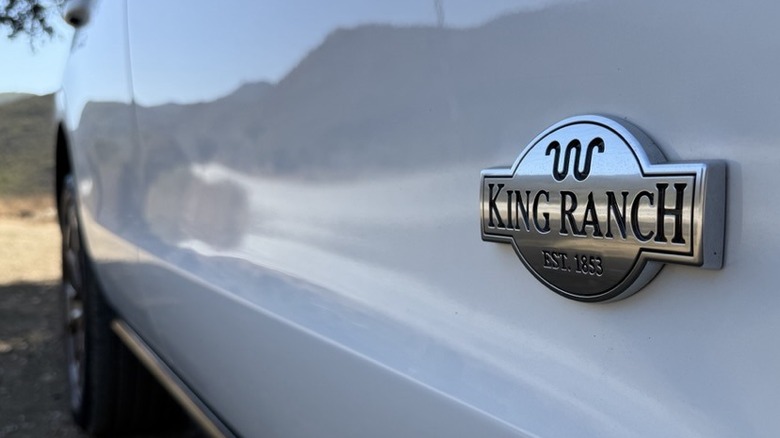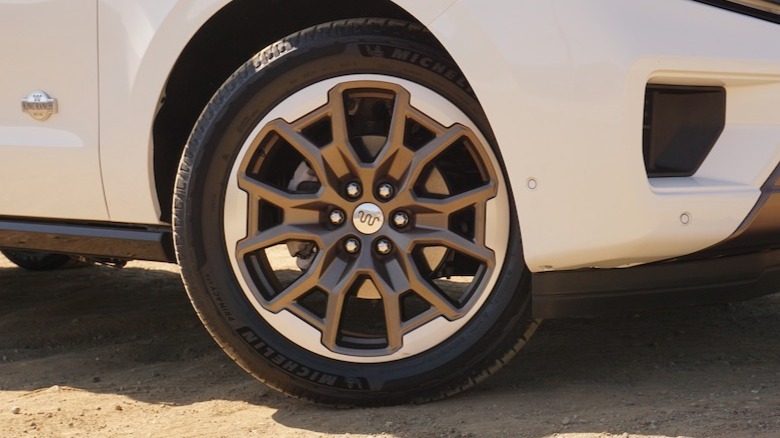Ford's 2025 Expedition Is Huge, And That's A Blessing And A Curse
Forget the small family haulers. Leave the keys to your midsize SUV at home. Got one of those puny crossovers? Punt it towards the goal posts. In Expedition town, there's no room for small fries. The Ford Expedition is one of the biggest SUVs money can buy, with three adult-sized rows of seating, impressive cargo space, and hauling capabilities that rival full-size pickup trucks. And it's no wonder it's so capable: it shares a lot of its underpinnings with Ford's popular full-size truck, the F-150.
The Expedition has been redesigned for 2025 but it still has all the same capability that's kept it neck and neck with class rivals like the Chevy Tahoe, Jeep Wagoneer, Toyota Sequoia, and Nissan Armada. The big Ford also has the latest interior tech, with massive screens, modern driver aids, and a properly powerful stereo. At the top of its trim-level hierarchy, the newest Ford Expedition King Ranch is packed with features and ready to transport your family around in comfort.
Just the V6, but that's more than enough
The Expedition is available with just one powertrain, sort of. Technically, every Expedition is powered by a turbocharged 3.5-liter V6 that's paired with a 10-speed automatic transmission. It puts out some healthy numbers too: 400 horsepower and 480 lb-ft of torque on base trims. It does get more power, though, if you pick a higher trim level. The High-Output version of the V6 makes 440 hp and 510 lb-ft with the upper trim levels.
Lots of other SUVs in the class have gone the one-turbocharged-V6 route, but the Expedition's main rival, the recently-updated Chevy Tahoe, flanks it on all sides with three different powertrain choices: a 3.0-liter turbodiesel, a 5.3-liter V8, and a 6.2-liter V8. Even if the Ford's engine bay feels like it could fit a big bulking V8, it isn't intimidated by the Chevy's wider selection.
The EcoBoost powering the Expedition feels strong for the class, pulling hard towards the horizon with the 10-speed automatic making quick shifts along the way. Making passes on the highway is easy and joining the speed of traffic on short on-ramps is no trouble at all. The V6 isn't exactly evocative, but it does provide a bit of growl and grunt if you bury your foot in the throttle.
Respectable pulling power and MPGs
The Expedition's maximum towing capacity of 9,600 lbs is excellent. You'll have to do some payload and GVWR math if you plan on hauling a trailer that big and bringing your family along, but most average-sized boats and car trailers won't come close to brushing up against that number. The Toyota Sequoia nearly keeps up with Expedition, offering a maximum towing capacity of 9,250 lbs, while the Chevy Tahoe maxes out at 8,400 lbs. The Jeep Wagoneer takes the lead with 10,000 pounds of towing capacity.
Fuel economy is, naturally, pretty underwhelming on big SUVs like the Expedition, so it's important to put that in context too. The Expedition gets an EPA estimate of 19 mpg combined (16 city/24 highway) on rear-wheel-drive models. Four-wheel drive drops the combined estimate by 1 mpg. That's not great, but it's better than every V8-powered version of the Chevy Tahoe or Suburban (only their diesel powertrain does better).
The Sequoia tops them both, however, with rear-wheel drive models offering 22 mpg combined and four-wheel drive models dropping to 20 mpg combined. I couldn't quite match the EPA numbers during my test, but the Expedition still returned mileage in the high-teens, close to the promised mark.
Captaining the ship
The engine is up to the task of moving the Expedition, but there's no getting around its sheer size. It's big and it drives that way. It takes a bit of planning, moving head position to see over the hood, and relying on faith to navigate tight spaces, as it's difficult to sense where the SUV's corners are. The handling capabilities are adequate for something with pickup-truck underpinnings and such a generous footprint, but the steering wheel really puts a damper on that part of the experience. Taking the Expedition around corners in the mountains is a bit of a tough task mostly because of its utterly strange oblong steering wheel.
It's not quite flat bottom, and it's certainly not round, but more like a circle that's been squished a bit. It's not intuitive in your hands and it felt strange every time I made a turn in the Expedition that required more than a quarter rotation in the steering wheel. Thankfully, the Expedition is quiet and comfortable over pretty much any road surface thanks to the continuously controlled damping (CCD) suspension. It is pretty high off the ground, and climbing into the cabin would be a chore if it weren't for the power-operated running boards, but they pop out quickly and retract just as fast. Watch out for your shins, though, the running boards will nail you a few times if you aren't paying attention.
Pricing is just as hefty as the footprint
With all the power, space, and capability offered in big truck-based three-row SUVs like the Expedition, the price tag is predictably large. There are four main trim levels for the Expedition: Active, Platinum, Tremor, and King Ranch. All but the off-road oriented Tremor are available in the extended version as well, known as the Expedition Max: it competes more directly with the Suburban.
The base Expedition Active has an MSRP of $64,995 (including $2,595 destination fee). The extended Max version adds $3,000 to that price tag. Along the ladder to the top of the trim levels, the Platinum checks in at $77,445, the Tremor creeps upward at $83,945, and the King Ranch trim ends the discussion at $86,595. The King Ranch trim is the model I drove around all week and it came packed to the brim with equipment, so the price felt justified, but still tough to swallow.
Modern equipment all around
A wide array of screen space dominates the Expedition's dashboard. A 24-inch panoramic display combines most of the gauges and some various other customizable information in front of the driver. If the dashboard were stadium seating, that would be the back row. The front row of the bleachers is the 13.2-inch center touchscreen. It's crisp, well organized and responds quickly to various commands. Wireless Apple CarPlay was easy to set up and it connected with lightning speed every time I started up the Expedition.
The 22-speaker B&O stereo provides some pretty impressive volume and sound quality. At the top of the volume range, there's a bit of distortion and loss of clarity but I seldom turned it up loud enough to notice. If the family brings along all their devices, they'll have somewhere to charge pretty much every one of them.
There are two USB ports up front for the driver and front passenger, along with a wireless charging pad. Then there are two USB ports for each second-row passenger, and two more for each outboard seating position in the third row. Let's not forget the three-prong outlets in the back of the center console and the cargo area. Features like adaptive cruise control, blind-spot monitoring, and parking sensors, are all part of the package too, and they all worked well during my week-long test.
Leave the labels on the buttons
The center console and driver display do a great job of conveying all the Expedition's important information with a quick glance, but the use of steering wheel buttons is a less intuitive part of the experience. The steering wheel has buttons, but most of them aren't labeled. It takes some trial and error to get to know the various commands and which screens they're connected to.
The steering wheel tilt-and-telescope settings and pedal adjustments need to be done via a menu in the touchscreen and the unlabeled steering wheel buttons, for example. I recently criticized the Polestar 3 for falling victim to this same minimalism, where interior design seems to value form over function. While it's not as bad in the Expedition, it's a trend that continues to creep into luxury and luxury-leaning vehicles, and I hope it's one that doesn't continue much longer.
Interior gives you all the space you need
It's not a bold revelation to say that something as large as the Expedition has a spacious interior, but it's worth pointing out that there's no measurement or metric where it disappoints. In all three rows, there's plenty of legroom, headroom, hip room, and shoulder room for adults. Climbing into the third row through the large passage between the two middle seats is easy, and the third row seats are nearly as comfortable as the two front rows.
The special Mesa Del Rio leather with Kingsville stitching feels relatively premium, but thick and sturdy enough to take abuse over time. Unfortunately, there were some frayed stitches in the cabin that threw off the vibe a little bit. They weren't in high-traffic areas (where you slide in and out of the driver's seat was fine for instance), so it felt a bit like a build-quality issue rather than a materials quality one. Seat heating and ventilation elements worked well, but the ventilated front seats were a bit loud when there wasn't music on to drown them out.
Oh, you needed even more space?
On top of having tons of interior real estate, the Expedition's small-item storage is laid out well too. The center console slides forward and back for extra front-row storage, there are big cupholders all around, and lots of door/back-seat pockets for your various flotsam and jetsam. Behind the third row of seats, there's 36.1 cubic feet of cargo space – enough for several suitcases or small duffel bags. Folding down the second and third row from the trunk is easily done with the push of a button and, with the second row folded, you get as much as 84.5 cubic feet of cargo space. Drop all the seats and cargo volume expands to 123.1 cubes.
The Multifunction split rear tailgate is excellent too. According to Ford, it can support up to 500 pounds: enough for even your biggest tailgating cooler full of beers. This isn't the first of its kind (luxury SUVs like the BMW X7 and Range Rover also offer split-open tailgates), but on a vehicle that's as big as the Expedition, it's a helpful rarity. When you've got your giant three-row SUV parked in the garage, opening the rear hatch might require a bit of extra space: a shorter overhang on the top section of the tailgate means you need less space to open things up. The lower half staying in place means the groceries or luggage you loaded in the back don't come tumbling out if you're parked on an incline.
2025 Ford Expedition verdict
I'll admit that I had some annoyances with the Expedition. I was perplexed by the lack of button labels and frustrated by the unintuitive shape of the steering wheel. But those weren't big enough issues to keep me from recommending it on the whole. It's expensive, sure, but so are vehicles like the latest Tahoe and Suburban, and just about everything else in its class that offers the same features and capability as the top-trim 2025 Ford Expedition. In other words, the price tag feels justified.
From the moment you climb up and slide into the cabin, it feels relatively well-built. A few frays in the upholstery stitching notwithstanding, there weren't many hollow plastics or underwhelming surfaces to distract from the upscale experience. Most of the Expedition's tech worked well while the powertrain is gutsy, more efficient than a number of rivals, and available with varying power levels depending on your needs. The Expedition's towing and cargo space numbers are amongst the best in the class, too. It's easy to drive considering its size and comfortable enough to make even a long road trip seem short and serene. It should be on your short list if you've got a big family and carpool duties on your weekly to-do list.
PS: Counting the King Ranch logos
When vehicles are particularly proud of their trim level, I count badges. In the last few months, I've counted quite a few logos on vehicles like the Cadillac CT5-V Blackwing and the Toyota 4Runner Trailhunter. Both had pretty high emblem/logo counts, but the CT5-V won out handily, sporting 26 "V" logos.
This time, what we're counting is the Expedition's King Ranch Logo, carried over from the actual Ranch with the same name in Texas. To start, there are six King Ranch logos on the seats (one on each headrest). Then, there's one on the center console and one on each of the front floor mats for a total of nine. From there, the outside has one on each wheel, bringing the total up to 13. Each of the front doors has a King Ranch emblem, bringing the count to 15. Finally, there's the emblem on the rear split gate which brings the total to 16. It's an admirable count, but not enough to keep up with the CT5-V Blackwing.
